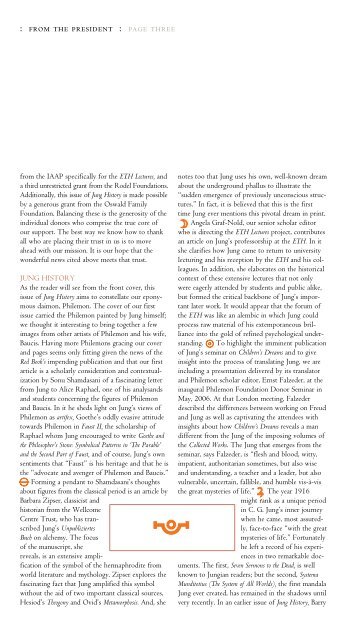a semi-annual publication of the philem n foundation - Philemon ...
a semi-annual publication of the philem n foundation - Philemon ...
a semi-annual publication of the philem n foundation - Philemon ...
You also want an ePaper? Increase the reach of your titles
YUMPU automatically turns print PDFs into web optimized ePapers that Google loves.
: from <strong>the</strong> president : page three<br />
from <strong>the</strong> IAAP specifically for <strong>the</strong> ETH Lectures, and<br />
a third unrestricted grant from <strong>the</strong> Rodel Foundations.<br />
Additionally, this issue <strong>of</strong> Jung History is made possible<br />
by a generous grant from <strong>the</strong> Oswald Family<br />
Foundation. Balancing <strong>the</strong>se is <strong>the</strong> generosity <strong>of</strong> <strong>the</strong><br />
individual donors who comprise <strong>the</strong> true core <strong>of</strong><br />
our support. The best way we know how to thank<br />
all who are placing <strong>the</strong>ir trust in us is to move<br />
ahead with our mission. It is our hope that <strong>the</strong><br />
wonderful news cited above meets that trust.<br />
JUNG HISTORY<br />
As <strong>the</strong> reader will see from <strong>the</strong> front cover, this<br />
issue <strong>of</strong> Jung History aims to constellate our eponymous<br />
daimon, <strong>Philemon</strong>. The cover <strong>of</strong> our first<br />
issue carried <strong>the</strong> <strong>Philemon</strong> painted by Jung himself;<br />
we thought it interesting to bring toge<strong>the</strong>r a few<br />
images from o<strong>the</strong>r artists <strong>of</strong> <strong>Philemon</strong> and his wife,<br />
Baucis. Having more <strong>Philemon</strong>s gracing our cover<br />
and pages seems only fitting given <strong>the</strong> news <strong>of</strong> <strong>the</strong><br />
Red Book’s impending <strong>publication</strong> and that our first<br />
article is a scholarly consideration and contextualization<br />
by Sonu Shamdasani <strong>of</strong> a fascinating letter<br />
from Jung to Alice Raphael, one <strong>of</strong> his analysands<br />
and students concerning <strong>the</strong> figures <strong>of</strong> <strong>Philemon</strong><br />
and Baucis. In it he sheds light on Jung’s views <strong>of</strong><br />
<strong>Philemon</strong> as artifex, Goe<strong>the</strong>’s oddly evasive attitude<br />
towards <strong>Philemon</strong> in Faust II, <strong>the</strong> scholarship <strong>of</strong><br />
Raphael whom Jung encouraged to write Goe<strong>the</strong> and<br />
<strong>the</strong> Philosopher’s Stone: Symbolical Patterns in ‘The Parable’<br />
and <strong>the</strong> Second Part <strong>of</strong> Faust, and <strong>of</strong> course, Jung’s own<br />
sentiments that “Faust” is his heritage and that he is<br />
<strong>the</strong> “advocate and avenger <strong>of</strong> <strong>Philemon</strong> and Baucis.”<br />
Forming a pendant to Shamdasani’s thoughts<br />
about figures from <strong>the</strong> classical period is an article by<br />
Barbara Zipser, classicist and<br />
historian from <strong>the</strong> Wellcome<br />
Centre Trust, who has transcribed<br />
Jung’s Unpubliziertes<br />
Buch on alchemy. The focus<br />
<strong>of</strong> <strong>the</strong> manuscript, she<br />
reveals, is an extensive amplification<br />
<strong>of</strong> <strong>the</strong> symbol <strong>of</strong> <strong>the</strong> hermaphrodite from<br />
world literature and mythology. Zipser explores <strong>the</strong><br />
fascinating fact that Jung amplified this symbol<br />
without <strong>the</strong> aid <strong>of</strong> two important classical sources,<br />
Hesiod’s Theogony and Ovid’s Metamorphosis. And, she<br />
notes too that Jung uses his own, well-known dream<br />
about <strong>the</strong> underground phallus to illustrate <strong>the</strong><br />
“sudden emergence <strong>of</strong> previously unconscious structures.”<br />
In fact, it is believed that this is <strong>the</strong> first<br />
time Jung ever mentions this pivotal dream in print.<br />
Angela Graf-Nold, our senior scholar editor<br />
who is directing <strong>the</strong> ETH Lectures project, contributes<br />
an article on Jung’s pr<strong>of</strong>essorship at <strong>the</strong> ETH. In it<br />
she clarifies how Jung came to return to university<br />
lecturing and his reception by <strong>the</strong> ETH and his colleagues.<br />
In addition, she elaborates on <strong>the</strong> historical<br />
context <strong>of</strong> <strong>the</strong>se extensive lectures that not only<br />
were eagerly attended by students and public alike,<br />
but formed <strong>the</strong> critical backbone <strong>of</strong> Jung’s important<br />
later work. It would appear that <strong>the</strong> forum <strong>of</strong><br />
<strong>the</strong> ETH was like an alembic in which Jung could<br />
process raw material <strong>of</strong> his extemporaneous brilliance<br />
into <strong>the</strong> gold <strong>of</strong> refined psychological understanding.<br />
To highlight <strong>the</strong> imminent <strong>publication</strong><br />
<strong>of</strong> Jung’s <strong>semi</strong>nar on Children’s Dreams and to give<br />
insight into <strong>the</strong> process <strong>of</strong> translating Jung, we are<br />
including a presentation delivered by its translator<br />
and <strong>Philemon</strong> scholar editor, Ernst Falzeder, at <strong>the</strong><br />
inaugural <strong>Philemon</strong> Foundation Donor Seminar in<br />
May, 2006. At that London meeting, Falzeder<br />
described <strong>the</strong> differences between working on Freud<br />
and Jung as well as captivating <strong>the</strong> attendees with<br />
insights about how Children’s Dreams reveals a man<br />
different from <strong>the</strong> Jung <strong>of</strong> <strong>the</strong> imposing volumes <strong>of</strong><br />
<strong>the</strong> Collected Works. The Jung that emerges from <strong>the</strong><br />
<strong>semi</strong>nar, says Falzeder, is “flesh and blood, witty,<br />
impatient, authoritarian sometimes, but also wise<br />
and understanding, a teacher and a leader, but also<br />
vulnerable, uncertain, fallible, and humble vis-à-vis<br />
<strong>the</strong> great mysteries <strong>of</strong> life.” The year 1916<br />
might rank as a unique period<br />
in C. G. Jung’s inner journey<br />
when he came, most assuredly,<br />
face-to-face “with <strong>the</strong> great<br />
mysteries <strong>of</strong> life.” Fortunately<br />
he left a record <strong>of</strong> his experiences<br />
in two remarkable documents.<br />
The first, Seven Sermons to <strong>the</strong> Dead, is well<br />
known to Jungian readers; but <strong>the</strong> second, Systema<br />
Munditotius (The System <strong>of</strong> All Worlds), <strong>the</strong> first mandala<br />
Jung ever created, has remained in <strong>the</strong> shadows until<br />
very recently. In an earlier issue <strong>of</strong> Jung History, Barry


